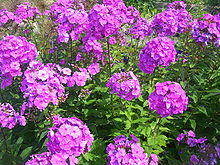Phlox
| Phlox | |
|---|---|
 |
|
| Phlox paniculata (Garden Phlox) | |
| Scientific classification | |
| Kingdom: | Plantae |
| (unranked): | Angiosperms |
| (unranked): | Eudicots |
| (unranked): | Asterids |
| Order: | Ericales |
| Family: | Polemoniaceae |
| Genus: |
Phlox L. |
| Species | |
|
See text |
|
See text
Phlox (/ˈflɒks/; Greek φλόξ "flame"; plural "phlox" or "phloxes", Greek φλόγες phlóges) is a genus of 67 species of perennial and annual plants in the family Polemoniaceae. They are found mostly in North America (one in Siberia) in diverse habitats from alpine tundra to open woodland and prairie. Some flower in spring, others in summer and fall. Flowers may be pale blue, violet, pink, bright red, or white. Many are fragrant.
Fertilized flowers typically produce one relatively large seed. The fruit is a longitudinally dehiscent capsule with three or more valves that sometimes separate explosively.
Some species such as P. paniculata (garden phlox) grow upright, while others such as P. subulata (moss phlox, moss pink, mountain phlox) grow short and matlike.
The foliage of Phlox is a food for the larvae of some Lepidoptera species including dot moth, Gazoryctra wielgusi, hummingbird hawk-moth and Schinia indiana (which feeds exclusively on P. pilosa). Phlox species are also a popular food source for groundhogs, rabbits and deer.
...
Wikipedia
